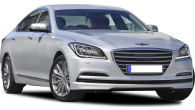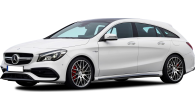There's a four-leaf clover on the fire-breather's flanks and a range to take on Germany's mid-size sedans.
It's refreshing to come across a car that has a name and not a designation.
Alfa Romeo's challenger for the BMW M3 and Mercedes-Benz C63 S has two — Giulia and Quadrifoglio (QV), which is Italian for four-leaf clover.
It also has a sparkling personality to go with the romantic Italian moniker.
The character is evident the minute you slip into the heavily bolstered, stitched and quilted leather seats. Press the red button on the steering wheel — just like a Ferrari — and a sweet-sounding twin-turbo V6 wakes with a spit and growl.
Press the accelerator and you're off in a puff of smoking rubber, on your way to 100km/h in what Alfa claims is a neck-snapping 3.9 seconds.
We didn't put the stopwatch on it but by the seat of the pants this car feels not only seriously quick but also a potential match for the benchmark German sports sedans.
Initial impressions are reinforced at the first corner of the Alfa Romeo test track in Balocco near Milan in Italy. The brakes bite hard and the QV changes direction with the eagerness and surefootedness you'd expect of an M3 or C63S.
it is clear that the latest Alfa has the track smarts to live up to its rich racing pedigree.
It seems the secret to taking on the heavyweights of the division is to be a lightweight. The QV weighs in at a lithe 1524kg, thanks to the use of aluminium and carbon-fibre in the body and underpinnings.
Two former Ferrari engineers led the development of the car from a blank piece of paper and, while they deny the car has borrowed from Ferrari, there are elements that appear inspired by Maranello.
The steering is super direct and quick — initially, it's a little unnerving — and a carbon-fibre front splitter opens up during braking and cornering to improve downforce, in tandem with a bootlid mounted spoiler at the back.
The driveshaft is carbon-fibre, the rear wheels have torque vectoring to improve grip and drive out of corners and the weight is 50-50 front to rear.
After eight laps of the flowing circuit, it is clear that the latest Alfa has the track smarts to live up to its rich racing pedigree.
In the Quadrifoglio, the driver chooses from economy, normal, dynamic and track drive-mode settings, altering the car's throttle response, suspension, steering and brake feel. On other variants, the track setting is not available.
But you'd expect a circa-$150,000 car to feel special. The key to success in the mid-size prestige market is how the garden varieties look and feel.
For the QV, the starting price will be somewhere between a C63 S and an M3 (circa $140,000 to $150,000).
The range will kick off with a 2.0-litre four-cylinder turbo producing 147kW and costing roughly $60,000, which lines up with the entry level Benz and Jaguar's XE. That engine will also be available in a better equipped "super" version, along with a 2.2-litre turbo diesel.
A 205kW petrol turbo is expected to be available in a more expensive model, with the Quadrifoglio topping the range.
All are matched to an eight-speed auto.
We drove the base petrol and the diesel and were impressed with the performance of both. The diesel has plenty of low-down shove and was reasonably quiet, although our drive consisted mainly of freeway and country roads.
The 2.0 suits the character of the car better, though. It's a lively unit that likes to rev and it has a sporty snarl when pressed. The auto helps with intuitive, quick shifts.
The seats have good side support and you sit low in the seat, which helps to create a sporty feel.
Both cars felt nimble through the corners and comfortable yet composed over bumps, although most of the drive was on smooth roads. We'll reserve final judgment until the local drive early next year.
The steering is sharp and accurate, if lacking the weight and feedback of a 3 Series.
Driving enjoyment is enhanced by a cabin that wraps around the driver. The seats have good side support and you sit low in the seat, which helps to create a sporty feel.
The flat bottomed steering wheel is a good size and the minimalist approach to knobs and buttons is welcome. The screen menus are operated by a rotary knob, with menus that are logical and easy to navigate.
Passengers aren't forgotten, either, with decent rear legroom and a separate rear sunroof.
The car isn't perfect, though. The quality of the seat coverings and door trims is up there with the Germans but some switches and knobs feel a little cheap, while the centre display screen is small and lacks the clarity of its German rivals — the reversing camera, in particular, is too small.
The airconditioning in both cars we tested felt as if it would struggle with the demands of an Australian summer. We had both on a setting that would have created a blizzard in a Toyota. There were a couple of fit and finish issues as well.
Alfa Romeo Giulia 2017: Quadrifoglio Verde
| Engine Type | V6, 2.9L |
|---|---|
| Fuel Type | Premium Unleaded Petrol |
| Fuel Efficiency | 8.2L/100km (combined) |
| Seating | 4 |
| Price From | $61,820 - $71,060 |
Verdict
Overall, though, this is an impressive car. It looks stylish inside and out, it's fun to drive and has some clever technology.
The brutal Quadrifoglio might just turn out to be Alfa's good luck charm.
'Skunkworks' delivers a waft of success
The Alfa Giulia is a car born out of desperation and exasperation.
Alfa had initially planned to launch a new mid-size sedan in 2012 but Fiat boss Sergio Marchionne pulled the pin — his gut feeling was that the car wasn't right.
The design and engineering team went back to the drawing board and Alfa Romeo's future looked bleak.
In 2013, Marchionne began to marshal troops from the wider Fiat group, including two key Ferrari staff, with the aim of cracking the ultra-competitive mid-size sedan market dominated by the BMW 3 Series and Mercedes-Benz C-Class.
A "skunkworks"-style team was assembled and cordoned off from the rest of Fiat — they even had unique security passes. They had three years to develop an all-new platform.
Working unconventionally, the group started on the top-spec fire-breathing Quadrifoglio and worked their way down to the cooking variety models so the magic dust would rub off.
In typical Ferrari style, they started off with a lap time as an initial goal: lapping enemy territory, Germany's famed Nurburgring circuit, in under 7 minutes 40 seconds.
The car had to have best-in-class fuel efficiency. It also had to conquer the quality gremlins that plagued earlier versions of the brand.
Last year there was another hurdle and the project was delayed a further six months. In Geneva earlier this year Marchionne said he decided to delay the car because the project was "technically immature".
With the bugs ironed out and pre-launch jitters subsiding, it's now up to the market to decide whether one of the world's most fabled marques has a future.
Click here to see more 2016 Alfa Romeo Giulia pricing and spec info.
Pricing Guides

.jpg)
.jpg)
.jpg)
.jpg)
.jpg)
.jpg)
.jpg)
.jpg)
.jpg)
.jpg)
.jpg)
.jpg)



.jpg)
















.jpg)
_0.jpg)



